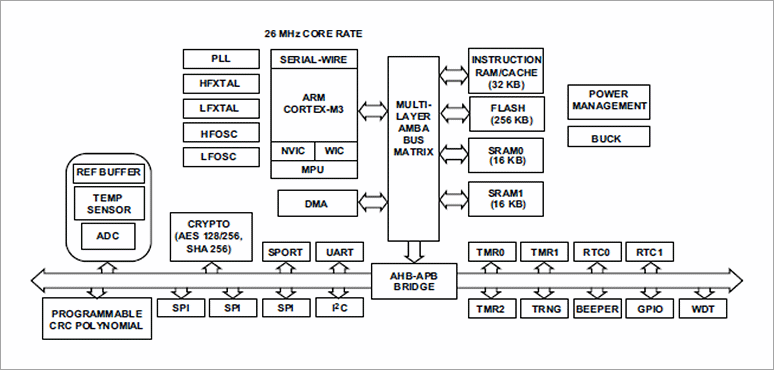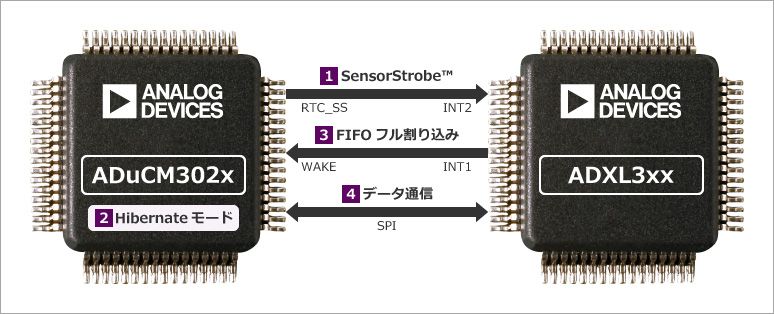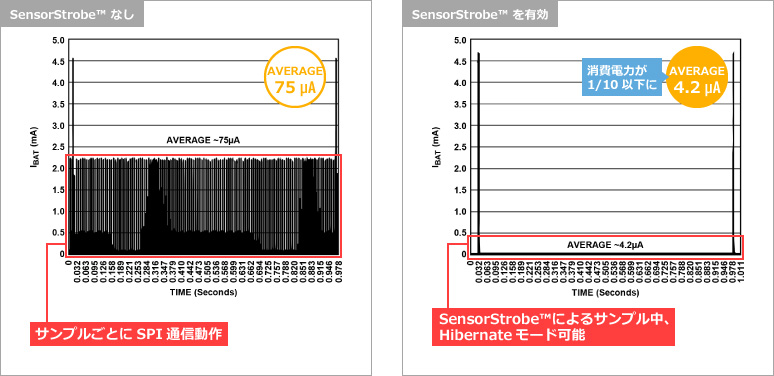ADuCM3029 is a microcontroller product from Analog Devices. ADI releases various types of processor products, including DSP.
Highly rated for its ultra-low power consumption
Now, the biggest appeal of the ADuCM3029 is its "ultra-low power consumption." This is supported by the high score of "245.5" from EEMBC's ULP Bench, a third-party organization.
The ADuCM3029 features ultra-low power consumption while incorporating high-precision analog blocks for precise control and measurement. It is also a microcontroller that can be used for a variety of applications including IoT.
M3 consumes less power than M0
The core of the ADuCM3029 is an Arm® Cortex®-M3. When we think of low power consumption microcontrollers, we think of M0/M0+, but the recent trend is for M3/M4F cores to become mainstream.
When thinking of the IoT, there is an increasing demand for calculating and analyzing data on the sensor node side and then sending only the results, rather than sending all measured data to the host/cloud side. Although it depends on the processing content, it is generally said that when the same calculation is performed with M0 and M3, the calculation time is shorter with M3. The processor power shortens the core operating time, and the M3 can consume less power overall.
Therefore, recently, there has been an increase in the number of low-power microcontrollers that use M3/M4F cores, and one of them is the ADuCM3029.

No external DC-DC required
To achieve ultra-low power consumption, the ADuCM3029 includes a power management mechanism that includes a step-down converter to increase power efficiency, as well as built-in power monitoring. Therefore, the power management system is complete, so there is no need for an external DC-DC.
Furthermore, in addition to simply requiring low power consumption, it is equipped with security functions (H/W encryption accelerator, random number generator, etc.) and also supports mechanisms to protect user code. The built-in memory has an ECC/parity function to ensure system safety.
Features of the ADuCM3029
- Ultra-low power Arm® Cortex®-M3 MCU
- Maximum operating frequency: 26MHz
- Supports four flexible operating modes (see 4 Operating Modes for Low Power Consumption for details)
- Supports single coin cell (e.g. CR2032)
- Power supply range (VBAT): 1.74 to 3.6V
- Powerful power management system installed
- Built-in 1.2V LDO
- Built-in high-efficiency Buck converter for low power consumption
- Power gating to reduce leakage current
- Built-in power supply voltage monitor (VBAT, VREG)
- Built-in memory
- Flash memory with ECC function: 256KB
- Cache memory: 4KB
- SRAM with parity function: 64KB
- Enhanced safety performance and security functions (For details, please refer to Realization of Safety and Security Functions)
- Rich peripherals and DMA engine installed
- SPI x 3, I2C, UART, SPORT (Serial Port), GP Timer x 3, WDT, RTC x 3, Beep Generator, Random Number Generator, GPIO x 44 (Max)
- 25ch DMA (peripheral-memory, memory-memory)
- Select the system clock that matches the operating mode
- 26MHz
- Internal oscillator (HFOSC), external crystal oscillator (HFXTAL): 26MHz or 16MHz
- GPIO clock input possible (SYS_CLK_IN)
- 32.768KHz
- Internal oscillator (LFOSC), external crystal oscillator/external clock input (LFXTAL)
- Built-in PLL
- Generate 26MHz from 16MHz
- Equipped with programmable frequency divider (24MHz, 20MHz...)
- 26MHz
Four operating modes for low power consumption
The ADuCM3029 has the following four modes, which can be combined according to system factors.
1. Active mode: < 30uA/MHz
- Full operation with all functions enabled (execute instructions from Flash/SRAM)
- Power-saving options also available
- Dynamic clock scaling lowers the operating clock to reduce power consumption
- Automatically applies clock gating to disabled peripherals, etc.
2. FLEX mode: <300uA
- Stop core only (Clock gating to core), peripherals available
- Data can be transferred in the background using DMA between peripherals and memory.
3.Hibernate mode: <750nA
- Power down the core and digital peripherals
- Set SRAM area, GPIO pin content retention
- Wakeup interrupt from external wakeup, only valid RTC can be used
4. Shutdown mode: <60nA
- Power down all digital and analog circuits (no SRAM retention: perform POR after wakeup)
- Only RTC and WakeUp interrupts work

Enabling safety and security features
In addition to low power consumption performance, "security performance" and "safety" are also important factors in the performance of sensor nodes required in IoT. This has several aspects,
- Protecting user code
- Protection from malicious access
- Data security from sensor to cloud
- Safe execution of code
These factors are considered to be an important factor for IoT sensor nodes.
AES-128 processing comparison
Let's try to implement encryption using a common key to protect user code.
If AES-128 were processed in software, this would consume 1,728 cycles. At this point, the core consumption cycle takes a long time, and even if you build a system with low power consumption, it will be ruined.
For the ADuCM3029, the encryption unit is implemented in hardware. Since all cryptographic instructions are executed in hardware, AES-128 processing can be performed at high speed in about 40 cycles without going through the core. Therefore, it is possible to achieve both low power consumption and security functions.

ADuCM3029 Security/Safety Features
- Hardware-accelerated cryptography
- AES-128, AES-256, SHA-256 support
- Built-in true random number generator (TRNG)
- Robustness with memory error detection function
- Built-in Flash: ECC function enables 1-bit error correction and 2-bit error detection
- Built-in SRAM: Implements parity error detection
- Hardware-implemented programmable 32-bit CRC engine
- Monitoring by watchdog timer (WDT)
- Provides a mechanism to avoid software attacks
- Read protection, in-circuit write protection, etc.
SensorStrobe™ feature enables synchronous sampling of sensors with low power consumption
Some Analog Devices sensor products have the ability to measure data using synchronized sampling points. This provides the ability to synchronize acceleration sampling to an external trigger signal. Synchronous sampling is possible with low power consumption by using the sensor-side FIFO and the ADuCM3029's SensorStrobe™ feature.
How the SensorStrobe™ feature works
The SensorStrobe™ feature allows the ADuCM3029 to continuously measure data from the sensor while in Hibernate mode. The operation will be as follows.
- Assign the RTC output of the ADuCM3029 to SensorStrobe™ and periodically output a trigger signal
- ADuCM3029 transitions to Hibernate mode
- WakeUp when ADXL3xx FIFO is full
- Import data in FIFO using SPI etc.

By effectively utilizing SensorStrobe™ and FIFO as described above, it is possible to reduce power consumption to less than 1/10.

Various devices compatible with SensorStrobe™ (as of December 2017)
- Optical measurement front end
- ADPD103
- ADPD105
- ADPD107
- 3-axis accelerometer
- ADXL345
- ADXL346
- ADXL350
- Ultra-low power consumption 3-axis acceleration sensor
- ADXL362
- ADXL363
- wireless walkie talkie
- ADF7030-1
- Low noise 3-axis acceleration sensor
- ADXL355
- ADXL357
- High-g 3-axis acceleration sensor
- ADXL372
- ADXL373
Introducing the ADuCM3029 Development Environment and Evaluation Board
- software development tools
- IAR EWARM v7.60.2 or later
- Keil uVision v5.23 or later
- ADI CCES 2.6.0 or later
- emulator
- IAR/Keil: J-Link Lite
- CCES: J-Link Lite or ICE-1000/2000
*J-Link Lite is included with the EZLite evaluation board.

Click here to purchase products
Click here for recommended articles/materials
Inquiry
If you have any questions regarding this article, please contact us below.
Analog Devices Manufacturer Information Top
If you want to return to Analog Devices Manufacturer Information Top, please click the button below.
